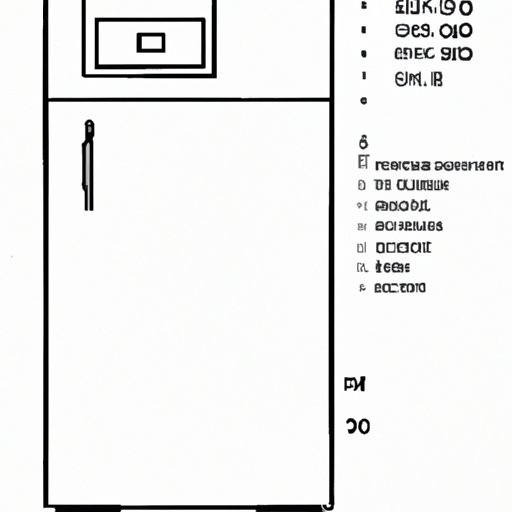Introduction
When shopping for a new refrigerator, it’s important to consider the size of the appliance that best suits your needs. The size of your refrigerator affects its capacity, energy efficiency, and overall cost. Knowing the standard size of a refrigerator can help you make an informed decision when purchasing a new one.
Why Refrigerator Size Matters
Refrigerators come in a variety of sizes, from small countertop models to full-size units. When determining the size of refrigerator you need, there are several factors to consider, such as the amount of food you need to store, the size of your kitchen, and the type of refrigerator you prefer. The size of your refrigerator can also affect its energy efficiency and cost.
Overview of Refrigerator Sizes and Dimensions
The standard size of a refrigerator varies depending on the type of refrigerator you purchase. There are three main types of refrigerators: top-freezer, bottom-freezer, and side-by-side. Top-freezer refrigerators typically range from 21 to 33 inches wide, while bottom-freezer refrigerators usually range from 28 to 38 inches wide. Side-by-side refrigerators are usually between 30 and 36 inches wide.
What is the Average Size of a Refrigerator?
The average size of a refrigerator is about 70 inches tall, 30 to 36 inches wide, and 32 to 34 inches deep. However, the exact measurements of your refrigerator will depend on the type and model you purchase.

Standard Size of a Refrigerator
The standard size of a refrigerator is typically based on the number of cubic feet it holds. Most full-size refrigerators have a capacity of 18 to 22 cubic feet. Smaller refrigerators typically have a capacity of 10 to 12 cubic feet, while larger models can hold up to 25 cubic feet or more.
Factors That Affect Refrigerator Size
In addition to the type and model of refrigerator you choose, there are several other factors that can affect the size of your refrigerator. These include the amount of food you need to store, the size of your kitchen, and the type of features you want. Additionally, some refrigerators come with adjustable shelves and drawers, which can help maximize storage space.

How to Choose the Right Size Refrigerator for Your Home
When choosing the right size refrigerator for your home, there are several factors to consider. First, measure the area where the refrigerator will be located to ensure it fits properly. Second, consider how much food you need to store and the type of features you want. Finally, consider your budget and the energy efficiency rating of the refrigerator you are considering.

Exploring the Different Types of Refrigerators
The type of refrigerator you choose can affect the size of the unit. Top-freezer and bottom-freezer models are usually smaller than side-by-side units, but they offer more storage options for fruits and vegetables. Side-by-side models offer more room for storing large items like pizza boxes and platters, but they may not fit into narrow kitchens.
What Factors Should You Consider When Choosing a Refrigerator Size?
When choosing the right size refrigerator for your home, consider how much food you need to store, the size of your kitchen, and the type of features you want. Additionally, make sure to measure the area where the refrigerator will be located to ensure it fits properly. Finally, consider your budget and the energy efficiency rating of the refrigerator you are considering.
A Guide to Standard Refrigerator Dimensions
Below is a guide to standard refrigerator dimensions to help you determine the right size refrigerator for your home. Keep in mind that these dimensions do not include the handle or door depth.
Common Refrigerator Dimensions
Top-Freezer Refrigerators: 20 to 33 inches wide, 60 to 70 inches tall, 24 to 30 inches deep.
Bottom-Freezer Refrigerators: 28 to 38 inches wide, 60 to 70 inches tall, 24 to 30 inches deep.
Side-by-Side Refrigerators: 30 to 36 inches wide, 66 to 72 inches tall, 24 to 30 inches deep.

Pros and Cons of Different Refrigerator Sizes
Smaller refrigerators are ideal for those who don’t need to store a lot of food, but they can be difficult to organize. Larger refrigerators offer more storage space, but they can be more expensive and less energy efficient. Side-by-side models are great for storing large items, but they may not fit into narrow kitchens.
Conclusion
When shopping for a new refrigerator, it’s important to consider the size of the appliance that best suits your needs. The size of your refrigerator affects its capacity, energy efficiency, and overall cost. Knowing the standard size of a refrigerator can help you make an informed decision when purchasing a new one. The average size of a refrigerator is about 70 inches tall, 30 to 36 inches wide, and 32 to 34 inches deep, but the exact measurements of your refrigerator will depend on the type and model you purchase.
When choosing the right size refrigerator for your home, consider how much food you need to store, the size of your kitchen, and the type of features you want. Additionally, make sure to measure the area where the refrigerator will be located to ensure it fits properly. Finally, consider your budget and the energy efficiency rating of the refrigerator you are considering.
Summary
When shopping for a new refrigerator, it’s important to consider the size of the appliance that best suits your needs. The average size of a refrigerator is about 70 inches tall, 30 to 36 inches wide, and 32 to 34 inches deep, but the exact measurements of your refrigerator will depend on the type and model you purchase. When choosing the right size refrigerator for your home, consider how much food you need to store, the size of your kitchen, and the type of features you want. Additionally, make sure to measure the area where the refrigerator will be located to ensure it fits properly.
Resources for Further Reading
U.S. Department of Energy – Energy Efficiency Tips for Refrigerators
Consumer Reports – Refrigerator Buying Guide
Home Depot –


